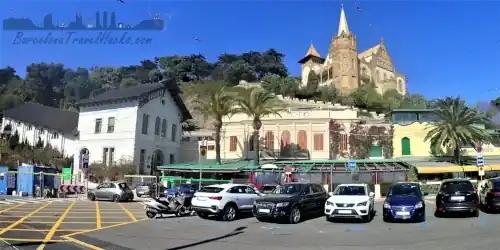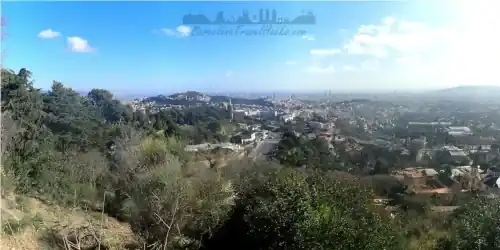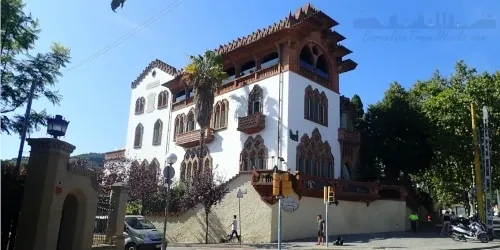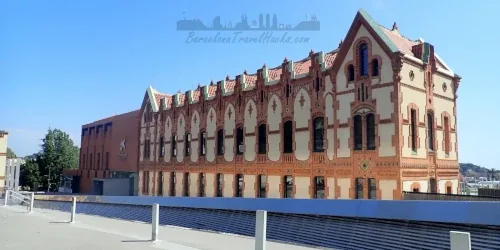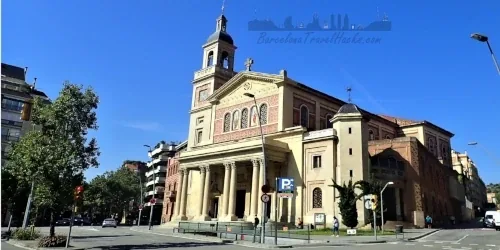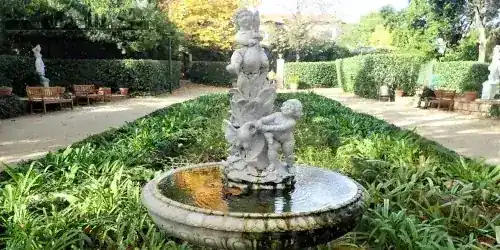About Torre Bellesguard Castle House
Torre Bellesguard, also known as Casa Figueres is currently owned by the Guilera family who still live in part of the Antoni Gaudí designed house. Gaudí remodelled the house from 1901 to 1909 in a Gothic art-nouveau style to reflect the already existing medival castle walls on the site.
The site is also famous in folklore for being the hide out of Joan Sala i Ferrer, also known as Serrallonga, a thief and bandit who was hunted by King Felipe IV of Spain's soldiers and finally captured, tortured and executed in Barcelona in 1634.
The site name Bellesguard in Catalan means viewpoint, watch point or beutiful views.
Torre Bellesguard could be considered as a prototype for the type of irregular use of stone in his constuctions, as well as incorporating symbology such as the Sant Jordi dragon. This type of construction can be seen in La Sagrada Família and Parc Güell.
Torre Bellesguard History
The site consists of the walls of an old castle that was the residence of Martín I the Humane, King of Aragón, Valencia, Sardinia and Corsica and Count of Barcelona from 1396 and King of Sicily from 1409. At the time of his death in 1410, all of Martín's legitimate descendants, born of his marriage with Queen María de Sicilia, were already dead.
His second marriage did not produce any children, Only an illegitimate grandson, Frederick, Count of Luna, a natural son of Martin the Younger, and an illegitimate daughter. All ineligible for succession due to the rules established during the times of James I the Conqueror. The king, despite his desire and some effort, was unable to obtain sufficient confirmation of Frederick as his successor prior to his death.
Within the medieval walls sits a house constructed by Gaudí between 1900 and 1909. Gaudí drew inspiration for Casa Figueras from the medieval castle that once stood on the same site, built for the King of Aragón in the early 15th century. When the King of Aragón died without an heir in 1410, his widow, Margaret of Prades, inherited the estate. Following her death, the castle fell into decline and was passed from hand to hand over centuries until Jaume Figueras i Burull purchased the estate.
Jaume Figueres died in 1877, leaving his widow, Maria Sagués i Molins, in charge of Gaudí for the project. All that remained of the initial structure were a few walls and the patio. Still, Gaudí was aware of the important history this location so he worked to preserve the medieval spirit of the ruins repairing the outer castle walls. Gaudí sought to blend the construction with its natural surroundings, hence the exterior is made with stone slate.
Gaudí decorative elements resonate with the natural surroundings together with the usual gothic characteristics. The facade of the structure is still best understood as neo-gothic, though there is no denying the modernist elements. Gaudí designed the home in a period where he himself was still developing his unique style. For instance, while the building displays Gaudí's iconic mosaic detailing and incorporation of natural elements, it does not include Moorish accents and bright colours (aside from the stripes on the tower cross), which are key distinctive characteristics in much of his later works.
Gaudí was given free rein to design and construct what was intended as a second home for the Figueres family, however this freedom bestowed to the artist later proved disastrous for the family. Figueres died before the construction had finished, leaving the responsibility of overseeing the final construction to his wife, who grew increasingly frustrated with constant delays due to Figueres's obsessive detailing.
While the months Gaudí dedicated to placing trencadis (his iconic mosaic detailing) on the structure are part of what makes the home so beautiful today, the process added such significant time and cost to the construction that Maria Sagués i Molins was never actually able to live in the home and even had to sell it to avoid bankruptcy.
The house changed hands for several years until the Guilera family purchased the home in 1944 and has continued to own. When Lluís Guilera Molas first bought Casa Figueres in 1944, the doctor intended to convert the building into a modernist hospital, similar to Sant Pau, dedicated to cancer treatment and research. The building continued to serve medical purposes following Lluís' death in 1969 when his son, Lluís Guilera Soler, a gynecologist and obstetrician, inherited the home and hospital.
Several Barcelona citizens were born in Casa Figueres until 1974 when the site of the hospital relocated to a more accessible area better suited to medical needs. From that point on, the building has served the purpose that Gaudí always intendeded as a private home.
For the past 30 years, the Guilera family has left the gates open permitting guests to stroll the gardens and observe the home's exquisite exterior. Over the years, they received countless requests from visitors to explore inside the home and enjoy Gaudí's more modernist interior detailing.
Due to the popular demand from visitors as well as the family's realisation that restoration was necessary, the Guilera family began plans to open their home to the public in 2009. The family officially began inviting tours in September 2013, offering access to the interior accompanied by explanations of the history and architecture.
Visiting Torre Bellesguard Castle House
Torre Bellesguard is still a private home. Access to the interior only includes the wonderfully mosaic staircase, what was the smoking room on the first floor, the attic with the brick arches, the roof terrace, the stables and the garden. The revenue generated from the ticket sales is used to assist in preserving the house.
Torre Bellesguard visiting hours for English language tours
Note: Tour times may vary seasonally and are subject to the demands to generate venue to preserve the building and grounds.
- Tuesday's to Sunday's: 11:00h and 13:00h
- Closed: Monday's; 1st and 6th of January; 25th and 26th of December
It is recommended to book in advance as places are limited. Tours are available in Spanish or Catalan at other hours of the day.
Other Gaudí Works
The House that Gaudí Lived in, is located in Parc Güell but not included in the Sagrada Família ticket. I recommend buying a combined Parc Guell + Gaudí House Museum ticket. Details on the Parc Güell Page.
My recommendation is to combine a visit to Casa Batlló with La Perdera/Casa Milá because it is only a 500 metre walk from casa Batlló, higher up in Passeig de Grácia.
For The grandest of Gaudí's works in Barcelona, visit La Sagrada Família.
You will also find Gaudí's Palau Güell near to the bottom of Las Ramblas and Casa Vinçens in the Grácia Neighbourhood.
Each of these Gaudí wonders are visually distinct and each one its own masterpiece.
What to take with you for Torre Bellesguard Castle House
Torre bellesguard is a private house with some areas open to the public. Access to the first floor and roof on the guided tour is via stairs. The garden is on one level but with an incline up to the house and with gravel paths.
There are no Bicycle anchorage points nearby.
There are no lockers so do not go with large bags. A small 10L rucksack would probably be permitted but you may have to wear it on your chest when inside the house.
Don't forget headphones for the audio guide.
